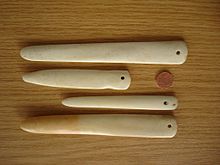Folder bone
The folder is a traditional tool used in artisanal paper processing . It is mainly used in the bookbinding trade as well as in the graphic trade (for example in the design of packs when making models and prototypes for cardboard outer packaging ).
A folding tool consists of a flat, 12 to 20 cm long piece Rinderbein- or whalebones (the word leg is here the name of the bone as a material) with a rounded tip and is for producing and flat rubbing of the wrinkle when folded ( folds ) of paper and Cardboard inserted.
With the folder, usually with a ruler as a guide, a groove is rubbed into the outside of the cardboard or paper. The cardboard or paper is turned over at this groove and rubbed flat. This procedure (folding) relaxes the paper or cardboard at the fold so that it does not break when it is bent. In this way, clean folds can be set with high precision. In the past, folder legs were also used for lining.
There are smaller, narrow leather folded legs, also known colloquially as bones, and larger ones with a round tip. The term “ elephant ” is also used (on the assumption that folding legs are made of ivory ). Today folding legs are also made of wood , plastic , stainless steel and Teflon .
Bone folding legs in particular are specially prepared by their owner and are considered a "personal" tool that is reluctant to be left to others.
literature
- Hammer: The folder . In: The bookbinder's apprentice . 8th year 1934, pp. 13-15.

